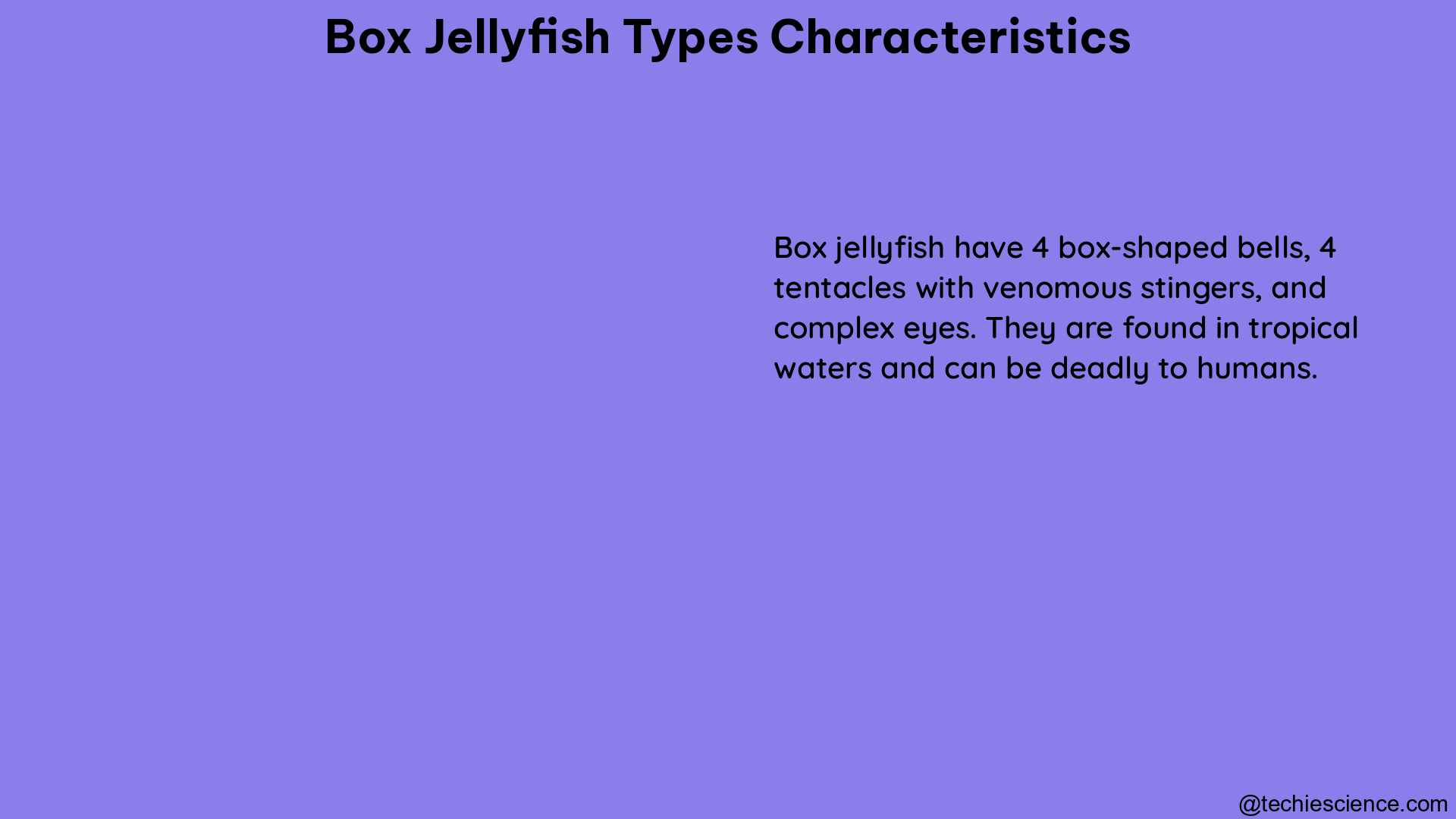Box jellyfish, also known as Cubozoa, are a class of cnidarian invertebrates that are distinguished by their box-like or cube-shaped body. These fascinating creatures possess a unique set of characteristics that set them apart from other marine invertebrates. In this comprehensive guide, we will delve into the intricate details of box jellyfish types and their measurable and quantifiable characteristics.
Size and Dimensions
The size of box jellyfish can vary significantly across different species. The bell diameter, which is the width of the cube-shaped body, can range from as small as 1 centimeter (0.4 inches) to as large as 30 centimeters (11.8 inches). This wide range in size is a testament to the diversity within the Cubozoa class.
The tentacles of box jellyfish are another impressive feature, with some species capable of extending their tentacles up to 3 meters (9.8 feet) in length. This remarkable reach allows them to effectively capture prey and defend themselves against potential predators.
Swimming Speed and Agility

Box jellyfish are renowned for their impressive swimming abilities, capable of achieving speeds of up to 1.5 to 2 meters per second, or approximately 4 knots (7.4 km/h; 4.6 mph). This speed is particularly remarkable when considering the cube-like shape of their bodies, which one might expect to be less hydrodynamic.
The agility of box jellyfish is also noteworthy, as they can quickly change direction and maneuver through their aquatic environment with ease. This agility is crucial for their hunting and survival strategies, allowing them to pursue and capture prey with remarkable efficiency.
Sophisticated Visual System
One of the most distinctive features of box jellyfish is their advanced visual system. Each adult box jellyfish possesses a remarkable 24 eyes, arranged in clusters around the bell. These eyes are capable of discerning between light and dark, and some species even have sophisticated eyes with a lens, cornea, iris, and retina.
This visual acuity is believed to play a crucial role in the box jellyfish’s hunting and navigation abilities, allowing them to detect and track their prey with remarkable precision. The complex visual system of box jellyfish is a testament to the evolutionary adaptations that have occurred within this class of cnidarians.
Venomous Tentacles and Nematocysts
The tentacles of box jellyfish are equipped with a formidable defense mechanism – nematocysts. These are capsules filled with tiny barbed hooks and a potent venom that can be fired into the bodies of prey. The venom of some box jellyfish species, such as the Australian box jellyfish (Chironex fleckeri), is particularly potent and can cause tissue necrosis, extreme pain, paralysis, cardiac arrest, and even death within minutes.
The ability to deliver a powerful venom through their nematocysts is a crucial adaptation that allows box jellyfish to subdue and consume their prey, which can range from small fish and crustaceans to larger marine animals. This venomous capability also serves as a defense mechanism against potential predators.
Growth and Lifespan
The growth and lifespan of box jellyfish are also noteworthy characteristics. Studies on the Australian box jellyfish (Chironex fleckeri) have revealed that their statoliths, which are small calcium carbonate structures, exhibit clear sequential incremental layers that are thought to be laid down on a daily basis.
This has enabled researchers to estimate the growth rates, ages, and age to maturity of these box jellyfish. For example, Chironex fleckeri is known to increase its inter-pedalia distance (the distance between the four pedalia or “legs”) by 3 millimeters (1/8 inch) per day, reaching an inter-pedalia distance of 50 millimeters (2 inches) when they are 45 to 50 days old.
Despite their impressive size and capabilities, box jellyfish have a relatively short lifespan. Both males and females typically become sexually mature at around two months of age and rarely live past nine months, highlighting the rapid life cycle of these remarkable creatures.
Diversity within the Cubozoa Class
The Cubozoa class encompasses a diverse range of box jellyfish species, each with its own unique characteristics and adaptations. Some of the notable box jellyfish species and their distinguishing features include:
-
Chironex fleckeri (Australian Box Jellyfish): Known for its potent venom, which can be fatal to humans, this species can grow up to 30 centimeters (11.8 inches) in bell diameter and has tentacles that can extend up to 3 meters (9.8 feet) in length.
-
Carukia barnesi (Irukandji Jellyfish): Despite its small size, with a bell diameter of only 2.5 centimeters (1 inch), the Irukandji jellyfish possesses a highly potent venom that can cause a severe and potentially life-threatening condition known as Irukandji syndrome.
-
Tripedalia cystophora: This species is known for its unique visual system, which includes a pair of specialized eyes called “rhopalia” that are capable of color vision and depth perception.
-
Chiropsalmus quadrumanus: This box jellyfish, found in the western Atlantic Ocean, can grow up to 20 centimeters (7.9 inches) in bell diameter and has a distinctive yellow or orange coloration.
-
Chiropsella bronzie: Commonly known as the “sea wasp,” this species is found in the Indo-Pacific region and is considered one of the most venomous box jellyfish, with a sting that can be fatal to humans.
These are just a few examples of the diverse range of box jellyfish species, each with its own unique set of characteristics and adaptations that have evolved to suit their specific ecological niches.
Conclusion
Box jellyfish, or Cubozoa, are a fascinating class of cnidarian invertebrates that possess a remarkable array of characteristics. From their impressive size and swimming abilities to their sophisticated visual systems and venomous tentacles, these creatures have evolved a unique set of adaptations that allow them to thrive in their aquatic environments.
By understanding the measurable and quantifiable data points on box jellyfish types and their characteristics, we can gain a deeper appreciation for the complexity and diversity of these remarkable marine organisms. Whether you are a biology student, a researcher, or simply someone with a fascination for the natural world, this comprehensive guide provides a wealth of information to explore the captivating world of box jellyfish.
References
- Wikipedia. (n.d.). Box jellyfish. Retrieved from https://en.wikipedia.org/wiki/Box_jellyfish
- Encyclopædia Britannica. (n.d.). Box jellyfish. Retrieved from https://www.britannica.com/animal/box-jellyfish
- Gershwin, L., Alderslade, P., & Davie, P. (2019). Chironex fleckeri, the great barrier reef’s giant box jellyfish (Cnidaria, Cubozoa), has been here all along. Scientific Reports, 9(1), 1-10. Retrieved from https://www.nature.com/articles/s41467-019-09681-1

Hello, I am Sugaprabha Prasath, a Postgraduate in the field of Microbiology. I am an active member of the Indian association of applied microbiology (IAAM). I have research experience in preclinical (Zebrafish), bacterial enzymology, and nanotechnology. I have published 2 research articles in an International journal and a few more are yet to be published, 2 sequences were submitted to NCBI-GENBANK. I am good at clearly explaining the concepts in biology at both basic and advanced levels. My area of specialization is biotechnology, microbiology, enzymology, molecular biology, and pharmacovigilance. Apart from academics, I love gardening and being with plants and animals.
My LinkedIn profile-